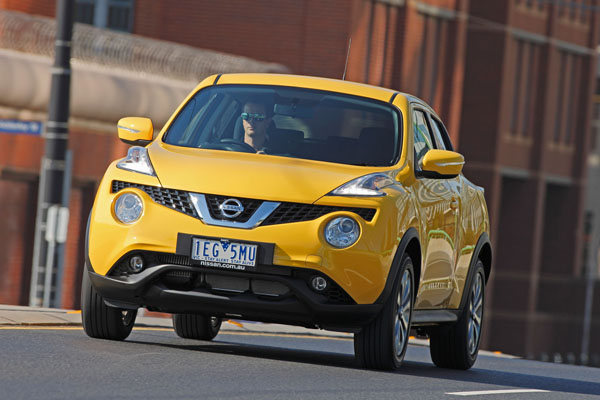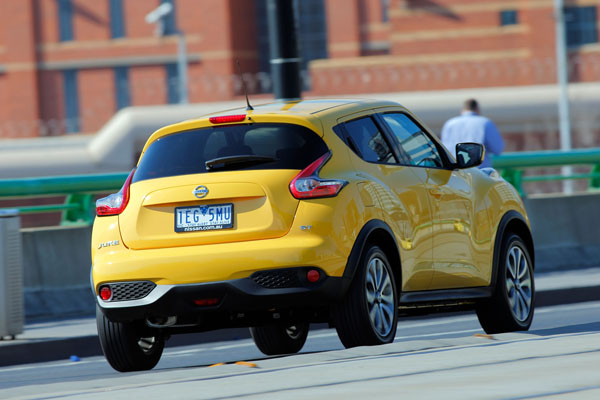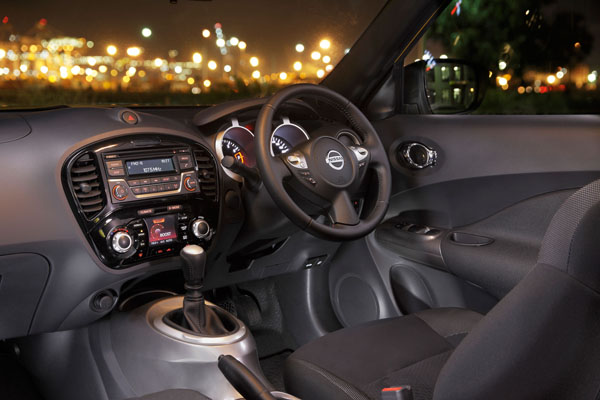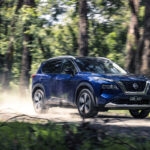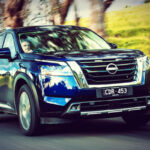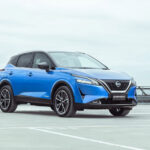Already a standout vehicle, even more so in the bright yellow model we’ve just stepped out of, Nissan Juke is now even more radical thanks to a major makeover that arrived a couple of months back.
Nissan Juke is all big curves and unexpected angle. While not to all tastes, indeed only suited to those who like to be different, we fell in love with it when we first saw a swag of them during several European trips. So radical was the style, with huge foglights that look like driving lights, and headlights that sit on top of the front guards (and look like blinkers) that Nissan Australia decided not to bring it downunder.
That is until other mini SUVs with interesting shapes arrived – Ford Kuga and Holden Trax being standouts – that Nissan decided it was time to bring it to our market.
STYLING
Juke Series 2’s frontal makeover is based on the Nissan so-called ‘V-Motion’ shape which gives it a big huge area and a slimmer upper section.
The Nissan designers tell us the headlights are based on a boomerang shape, we struggle to see any resemblance, perhaps the designers should be sent downunder for a while to do a rework!
The front and rear wheel arches bulge up and out and seemingly last forever. Juke can be mistaken as a crossover of an SUV and a two-door coupe thanks to its disguised rear door handles.
The rear bumper is bigger and the taillights, again, have what Nissan calls a boomerang design.
Juke’s blinkers previously sat on the top of the headlights. Many drivers found this distracting at night, so as part of the facelift the designers have shifted them to a conventional position in the door mirrors.
New colours have added, including Bumblebee Yellow (as on our test Juke), Magnetic Red and Ink Blue. It’s great to see a bit of colour coming back into cars in recent times.
Juke’s cabin isn’t as radical as the body, but oversize instruments, the centre console and gear lever housing continue the exterior’s curvaceous theme.
ENGINES / TRANSMISSIONS
There have been major changes under that bold bonnet. The biggest is the use of a 1.2-litre turbo-petrol engine. Fitted in the entry level 2WD Juke ST it produces 85 kW of power and 190 Nm of torque, it is mated to a six-speed manual gearbox. We found this combination performed well in the relatively light 2WD Juke.
The previous 1.6-litre non-turbo engine is still fitted to the 2WD Juke ST and has had some upgrades. It produces also 86 kW, but not being a turbo it doesn’t have the grunt, making just 140 Nm, which isn’t reached till it’s at a highish 4000 revs. It drives through a CVT automatic so is kept in the correct ratio virtually all the time.
The topline Juke Ti-S was our test vehicle. It has a turbocharged 1.6-litre petrol that’s also seen in the Nissan Pulsar SSS and produces up to 140 kW power and 240 Newton metres of torque. This torque is spread over an impressive range, all the way from 1600 to 5200 rpm. Most owners will therefore be getting peak grunt virtually all of the time. With 2WD this 1.6 turbo-petrol comes with a six-speed manual, but the AWD uses the CVT auto.
SAFETY
All Juke models get front, side and curtain airbags; stability and traction control; ABS brakes with electronic brakeforce distribution and brake assist; IsoFix child seat anchorages; and a reversing camera.
DRIVING
There’s good front headroom and the driver’s seat is comfortable and supports well in bends. The lack of telescopic steering wheel adjustment is a surprising omission.
The rear seat has reasonable legroom but it will sometimes be necessary for tall people in the back to do a deal with those in the front on longer trips. The original Nissan Juke with front-wheel-drive used the same rear underbody as the all-wheel-drive and there’s a big empty space under the floor of the 2WD where the rear differential wasn’t fitted. Sanity has prevailed and Juke’s with 2WD have gained a whopping 40 per cent more luggage space, at 354 litres. The Juke with AWD still has the smaller 251-litre boot of the first model. Folding rear seatbacks, with a 60/40 split, are used with both drivetrains.
The comfort / ride balance is good for most owners. Nissan Juke grips in corners and it will take a harsh driver to upset it, in which case the electronic aids will step in and help save them. However, if you’re looking for the sort of sportiness which Nissans often produce it’s best to look elsewhere.
SUMMING UP
Nissan Juke dares to be different – really different – so polarises opinions. We like it like that, vehicles in which no one has any real opinion one way or the other are usually sensible but boring; two words you are unlikely to see in any review on the Juke.
AT A GLANCE
MODEL RANGE
ST 2WD 1.2-litre: $23,490 (manual)
ST 2WD 1.6-litre: $24,490 (CVT automatic)
Ti-S 2WD 1.6-litre: $29,790 (manual)
Ti-S AWD 1.6-litre: $33,490 (CVT automatic)
Note: These prices do not include government or dealer delivery charges. Contact your local Nissan dealer for driveaway prices.
FEATURES
ABS Brakes: Standard in all models
Automatic Transmission: Optional in ST; not offered in Ti-S 2WD, standard in Ti-S AWD
Cruise Control: Standard in all models
Dual Front Airbags: Standard in all models
Front Side Airbags: Standard in all models
Electronic Stability Program: Standard in all models
Rear Parking Sensors: Not offered
Reversing Camera: Not offered in ST, standard in Ti-S
USB/Auxiliary Audio Inputs: Standard in all models
Satellite Navigation: Not offered in ST, standard in Ti-S
Bluetooth: Standard in all models
Steering Wheel Mounted Controls: Standard in all models
SPECIFICATIONS (Nissan Juke Ti-S 1.6-litre turbo petrol five-door SUV)
ENGINE:
Capacity: 1.618 litres
Configuration: Four cylinders in line
Head Design: DOHC, four valves per cylinder
Compression Ratio: 10.5:1
Bore/Stroke: 79.7 x 81.1 mm
Maximum Power: 140 kW @ 5600 rpm
Maximum Torque: 240 Nm @ 1600-5200 rpm
DRIVELINE:
Driven Wheels: AWD
Manual Transmission: Six-speed
Automatic Transmission: Continuously variable
Final Drive Ratio: 5.694:1
DIMENSIONS, WEIGHT AND CAPACITIES:
Length: 4135 mm
Wheelbase: 2530 mm
Width: 1765 mm
Height: 1565 mm
Turning Circle: 10.7 metres
Kerb Mass: 1431 kg
Fuel Tank Capacity: 46 litres
Towing Capacity: 728 kg (1150 kg with braked trailer)
Boot Capacity: 207 litres
SUSPENSION AND BRAKES:
Front Suspension: McPherson struts
Rear Suspension: Multi-link, torsion beam
Front Brakes: Ventilated disc
Rear Brakes: Sold disc
FUEL CONSUMPTION:
Type: Petrol 95RON
Consumption – Combined Cycle (ADR 81/02): 6.5 L/100km
GREEN VEHICLE GUIDE RATINGS:
Green Vehicle Guide Greenhouse Rating: To be rated
Green Vehicle Guide Air Pollution Rating: To be rated
STANDARD WARRANTY:
Three years/100,000km




